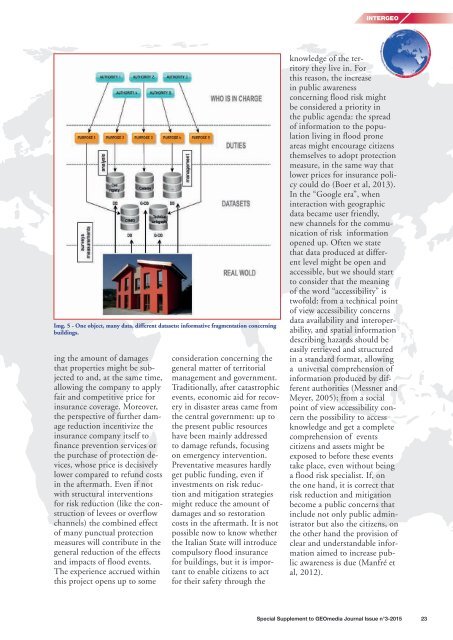GEOmedia 3-2015
Speciale INTERGEO 2015
Speciale INTERGEO 2015
You also want an ePaper? Increase the reach of your titles
YUMPU automatically turns print PDFs into web optimized ePapers that Google loves.
INTERGEO<br />
Img. 5 - One object, many data, different datasets: informative fragmentation concerning<br />
buildings.<br />
ing the amount of damages<br />
that properties might be subjected<br />
to and, at the same time,<br />
allowing the company to apply<br />
fair and competitive price for<br />
insurance coverage. Moreover,<br />
the perspective of further damage<br />
reduction incentivize the<br />
insurance company itself to<br />
finance prevention services or<br />
the purchase of protection devices,<br />
whose price is decisively<br />
lower compared to refund costs<br />
in the aftermath. Even if not<br />
with structural interventions<br />
for risk reduction (like the construction<br />
of levees or overflow<br />
channels) the combined effect<br />
of many punctual protection<br />
measures will contribute in the<br />
general reduction of the effects<br />
and impacts of flood events.<br />
The experience accrued within<br />
this project opens up to some<br />
consideration concerning the<br />
general matter of territorial<br />
management and government.<br />
Traditionally, after catastrophic<br />
events, economic aid for recovery<br />
in disaster areas came from<br />
the central government: up to<br />
the present public resources<br />
have been mainly addressed<br />
to damage refunds, focusing<br />
on emergency intervention.<br />
Preventative measures hardly<br />
get public funding, even if<br />
investments on risk reduction<br />
and mitigation strategies<br />
might reduce the amount of<br />
damages and so restoration<br />
costs in the aftermath. It is not<br />
possible now to know whether<br />
the Italian State will introduce<br />
compulsory flood insurance<br />
for buildings, but it is important<br />
to enable citizens to act<br />
for their safety through the<br />
knowledge of the territory<br />
they live in. For<br />
this reason, the increase<br />
in public awareness<br />
concerning flood risk might<br />
be considered a priority in<br />
the public agenda: the spread<br />
of information to the population<br />
living in flood prone<br />
areas might encourage citizens<br />
themselves to adopt protection<br />
measure, in the same way that<br />
lower prices for insurance policy<br />
could do (Boer et al, 2013).<br />
In the “Google era”, when<br />
interaction with geographic<br />
data became user friendly,<br />
new channels for the communication<br />
of risk information<br />
opened up. Often we state<br />
that data produced at different<br />
level might be open and<br />
accessible, but we should start<br />
to consider that the meaning<br />
of the word “accessibility” is<br />
twofold: from a technical point<br />
of view accessibility concerns<br />
data availability and interoperability,<br />
and spatial information<br />
describing hazards should be<br />
easily retrieved and structured<br />
in a standard format, allowing<br />
a universal comprehension of<br />
information produced by different<br />
authorities (Messner and<br />
Meyer, 2005); from a social<br />
point of view accessibility concern<br />
the possibility to access<br />
knowledge and get a complete<br />
comprehension of events<br />
citizens and assets might be<br />
exposed to before these events<br />
take place, even without being<br />
a flood risk specialist. If, on<br />
the one hand, it is correct that<br />
risk reduction and mitigation<br />
become a public concerns that<br />
include not only public administrator<br />
but also the citizens, on<br />
the other hand the provision of<br />
clear and understandable information<br />
aimed to increase public<br />
awareness is due (Manfré et<br />
al, 2012).<br />
Special Supplement to <strong>GEOmedia</strong> Journal Issue n°3-<strong>2015</strong> 23


















